Influence of Fiber Volume in Hybrid Short Glass/Cellulose Reinforced Thermoplastic Compounds
Abstract
:1. Introduction
2. Materials and Methods
2.1. Materials
2.1.1. Polymer Matrix
2.1.2. Fibers
2.2. Methods
2.2.1. Compounding
2.2.2. Injection Molding
2.2.3. Tensile Testing
2.2.4. Charpy Impact Test
2.2.5. 3-Point Bending Test
2.2.6. Rule of Hybrid Mixtures (RoHM)
2.2.7. SEM Microscopy
3. Results and Discussion
3.1. Tensile Test
3.2. 3-Point Bending Test
3.3. SEM Images
4. Conclusions
- GF reference specimens provide high strengths and stiffnesses in both tensile and 3-point bending tests due to the high properties of the fiber and good bonding to the matrix. An increase in the fiber volume content from 16 to 21% also results in higher strength and stiffness properties.
- For tensile strength, the predictions regarding RoHM are accurate. Only a slight deviation from the prediction can be seen. This applies to both fiber volume contents.
- Toughness values such as elongation at break and Charpy’s impact test show negative hybrid effects at both fiber volume contents. At a fiber volume content of 21%, the impact strength does not increase as long as GF are added to the compound (approx. 2.5 kJ/m2). Only the reference specimen with RCF shows a significantly higher impact strength of 33 kJ/m2. With the reference sample RCF and a load on the fiber in the tensile direction, a lower fiber volume fraction leads to higher toughness values (elongation at break). Loading transverse to the fiber direction at high speed (impact test) with higher fiber volume contents also leads to higher impact strengths in the RCF reference specimens.
- In the flexural modulus, the stiffness decreases with increasing RCF content. The sample RCF16/GF5 shows a lower stiffness than RCF8/GF8, although the fiber volume content is higher. For flexural strength, the value of RCF16/GF5 is higher than that of RCF8/GF8. Thus, the increasing GF content has an influence on the strength.
- The properties of the compounds can be understood in SEM images. RCF reference samples show very good toughness values in elongation at break and impact strength. This can be proven with long fiber pullouts. The high modulus and strength values in the tensile test and 3-point bending test can be explained by fiber fractures in the GF16 and RCF16/GF5 samples.
- The RCF16/GF5 sample shows that an addition of 5 vol% GF to 16 vol% RCF results in an increase in the mechanical properties in terms of stiffness and strength. This can be seen in the tensile tests as well as in the 3-point bending tests. On the other hand, the addition of GF also results in a significant decrease in the toughness values, which can be seen in the elongation at break in the tensile test and in the 3-point bending test, as well as in the Charpy impact tests.
Author Contributions
Funding
Institutional Review Board Statement
Data Availability Statement
Acknowledgments
Conflicts of Interest
References
- Franciszczak, P.; Kalniņš, K.; Błędzki, A. Hybridisation of man-made cellulose and glass reinforcement in short-fibre composites for injection moulding–Effects on mechanical performance. Compos. Part B Eng. 2018, 145, 14–27. [Google Scholar] [CrossRef]
- Artemenko, S.E.; Kadyk, Y.A. Hybrid Composite Materials. Fibre Chem. 2008, 6, 490–492. [Google Scholar] [CrossRef]
- Annandarajah, C.; Langhorst, A.; Kiziltas, A.; Grewell, D.; Mielewski, D.; Montazami, R. Hybrid Cellulose-Glass Fiber Composites for Automotive Applications. Materials 2019, 12, 3189. [Google Scholar] [CrossRef] [PubMed]
- Gemmeke, N.; Feldmann, M.; Heim, H.-P. Processing and characterization of engineering biocomposites based on polybutylenterephthalat (PBT) and polytrimethylentherephthalat (PTT) with regenerated cellulose fibers modified with maleic anhydride grafted polyethylene as a processing agent. Compos. Part A Appl. Sci. Manuf. 2019, 118, 327–335. [Google Scholar] [CrossRef]
- Holbery, J.; Houston, D. Natural-fiber-reinforced polymer composites in automotive applications. JOM 2006, 58, 80–86. [Google Scholar] [CrossRef]
- Ning, F.; He, G.; Sheng, C.; He, H.; Wang, J.; Zhou, R.; Ning, X. Yarn on yarn abrasion performance of high modulus polyethylene fiber improved by graphene/polyurethane composites coating. J. Eng. Fibers Fabr. 2021, 16, 1558925020983563. [Google Scholar] [CrossRef]
- Pickering, K.L.; Aruan Efendy, M.G.; Le, T.M. A review of recent developments in natural fibre composites and their mechanical performance. Compos. Part A Appl. Sci. Manuf. 2016, 83, 98–112. [Google Scholar] [CrossRef]
- Kahl, C.; Feldmann, M.; Sälzer, P.; Heim, H.-P. Advanced short fiber composites with hybrid reinforcement and selective fiber-matrix-adhesion based on polypropylene–Characterization of mechanical properties and fiber orientation using high-resolution X-ray tomography. Compos. Part A Appl. Sci. Manuf. 2018, 111, 54–61. [Google Scholar] [CrossRef]
- Romanzini, D.; Lavoratti, A.; Ornaghi, H.L.; Amico, S.C.; Zattera, A.J. Influence of fiber content on the mechanical and dynamic mechanical properties of glass/ramie polymer composites. Mater. Des. 2013, 47, 9–15. [Google Scholar] [CrossRef]
- Zarges, J.-C.; Kaufhold, C.; Feldmann, M.; Heim, H.-P. Single fiber pull-out test of regenerated cellulose fibers in polypropylene: An energetic evaluation. Compos. Part A Appl. Sci. Manuf. 2018, 105, 19–27. [Google Scholar] [CrossRef]
- Zuo, P.; Srinivasan, D.V.; Vassilopoulos, A.P. Review of hybrid composites fatigue. Compos. Struct. 2021, 274, 114358. [Google Scholar] [CrossRef]
- Mader, A.; Kondor, A.; Schmid, T.; Einsiedel, R.; Müssig, J. Surface properties and fibre-matrix adhesion of man-made cellulose epoxy composites–Influence on impact properties. Compos. Sci. Technol. 2016, 123, 163–170. [Google Scholar] [CrossRef]
- Kahl, C.; Gemmeke, N.; Bagnucki, J.; Heim, H.-P. Investigations on fiber–matrix properties of heat-treated and UV-treated regenerated cellulose fibers. Compos. Part A Appl. Sci. Manuf. 2021, 152, 106669. [Google Scholar] [CrossRef]
- Zarges, J.-C.; Minkley, D.; Feldmann, M.; Heim, H.-P. Fracture toughness of injection molded, man-made cellulose fiber reinforced polypropylene. Compos. Part A Appl. Sci. Manuf. 2017, 98, 147–158. [Google Scholar] [CrossRef]
- Feldmann, M.; Heim, H.-P.; Zarges, J.-C. Influence of the process parameters on the mechanical properties of engineering biocomposites using a twin-screw extruder. Compos. Part A Appl. Sci. Manuf. 2015, 83, 113–119. [Google Scholar] [CrossRef]
- Irfan, M.S.; Saeed, F.; Gill, Y.Q.; Qaiser, A.A. Effects of hybridization and fiber orientation on flexural properties of hybrid short glass fiber– and short carbon fiber–reinforced vinyl ester composites. Polym. Polym. Compos. 2018, 26, 371–379. [Google Scholar] [CrossRef]
- Kahl, C.; Schlink, A.; Heim, H.-P. Pultruded Hybrid Reinforced Compounds with Glass/Cellulose Fibers in a Polybutylene Terephthalate Matrix: Property Investigation. Polymers 2022, 14, 1149. [Google Scholar] [CrossRef]
- Rajpurohit, A.; Joannès, S.; Singery, V.; Sanial, P.; Laiarinandrasana, L. Hybrid Effect in In-Plane Loading of Carbon/Glass Fibre Based Inter- and Intraply Hybrid Composites. J. Compos. Sci. 2020, 4, 6. [Google Scholar] [CrossRef]
- Mansor, M.R.; Sapuan, S.M.; Zainudin, E.S.; Nuraini, A.A.; Hambali, A. Stiffness Prediction of Hybrid Kenaf/Glass Fiber Reinforced Polypropylene Composites using Rule of Mixtures (ROM) and Rule of Hybrid Mixtures (RoHM). J. Polym. Mater. 2013, 30, 321–334. [Google Scholar]
- Panthapulakkal, S.; Sain, M. Injection-molded short hemp fiber/glass fiber-reinforced polypropylene hybrid composites—Mechanical, water absorption and thermal properties. J. Appl. Polym. Sci. 2006, 103, 2432–2441. [Google Scholar] [CrossRef]
- Dai, H.-L.; Huang, Z.-W.; Mei, C.; Lin, Z.-Y. Prediction of the tensile strength of hybrid polymer composites filled with spherical particles and short fibers. Compos. Struct. 2018, 187, 509–517. [Google Scholar] [CrossRef]
- Ganster, J.; Fink, H.-P. Novel cellulose fibre reinforced thermoplastic materials. Cellulose 2006, 13, 271–280. [Google Scholar] [CrossRef]
- Ganster, J.; Fink, H.-P.; Pinnow, M. High-tenacity man-made cellulose fibre reinforced thermoplastics–Injection moulding compounds with polypropylene and alternative matrices. Compos. Part A Appl. Sci. Manuf. 2006, 37, 1796–1804. [Google Scholar] [CrossRef]
- Canché-Escamilla, G.; Rodriguez-Laviada, J.; Cauich-Cupul, J.; Mendizábal, E.; Puig, J.; Herrera-Franco, P. Flexural, impact and compressive properties of a rigid-thermoplastic matrix/cellulose fiber reinforced composites. Compos. Part A Appl. Sci. Manuf. 2002, 33, 539–549. [Google Scholar] [CrossRef]
- Bledzki, A.K.; Jaszkiewicz, A.; Scherzer, D. Mechanical properties of PLA composites with man-made cellulose and abaca fibres. Compos. Part A Appl. Sci. Manuf. 2009, 40, 404–412. [Google Scholar] [CrossRef]
- Khan, M.A.; Ganster, J.; Fink, H.-P. Hybrid composites of jute and man-made cellulose fibers with polypropylene by injection moulding. Compos. Part A Appl. Sci. Manuf. 2009, 40, 846–851. [Google Scholar] [CrossRef]
- Ghanbari, A.; Jalili, N.S.; Haddadi, S.A.; Arjmand, M.; Nofar, M. Mechanical properties of extruded glass fiber reinforced thermoplastic polyolefin composites. Polym. Compos. 2020, 41, 3748–3757. [Google Scholar] [CrossRef]
- Swolfs, Y.; Gorbatikh, L.; Verpoest, I. Fibre hybridisation in polymer composites: A review. Compos. Part A Appl. Sci. Manuf. 2014, 67, 181–200. [Google Scholar] [CrossRef]
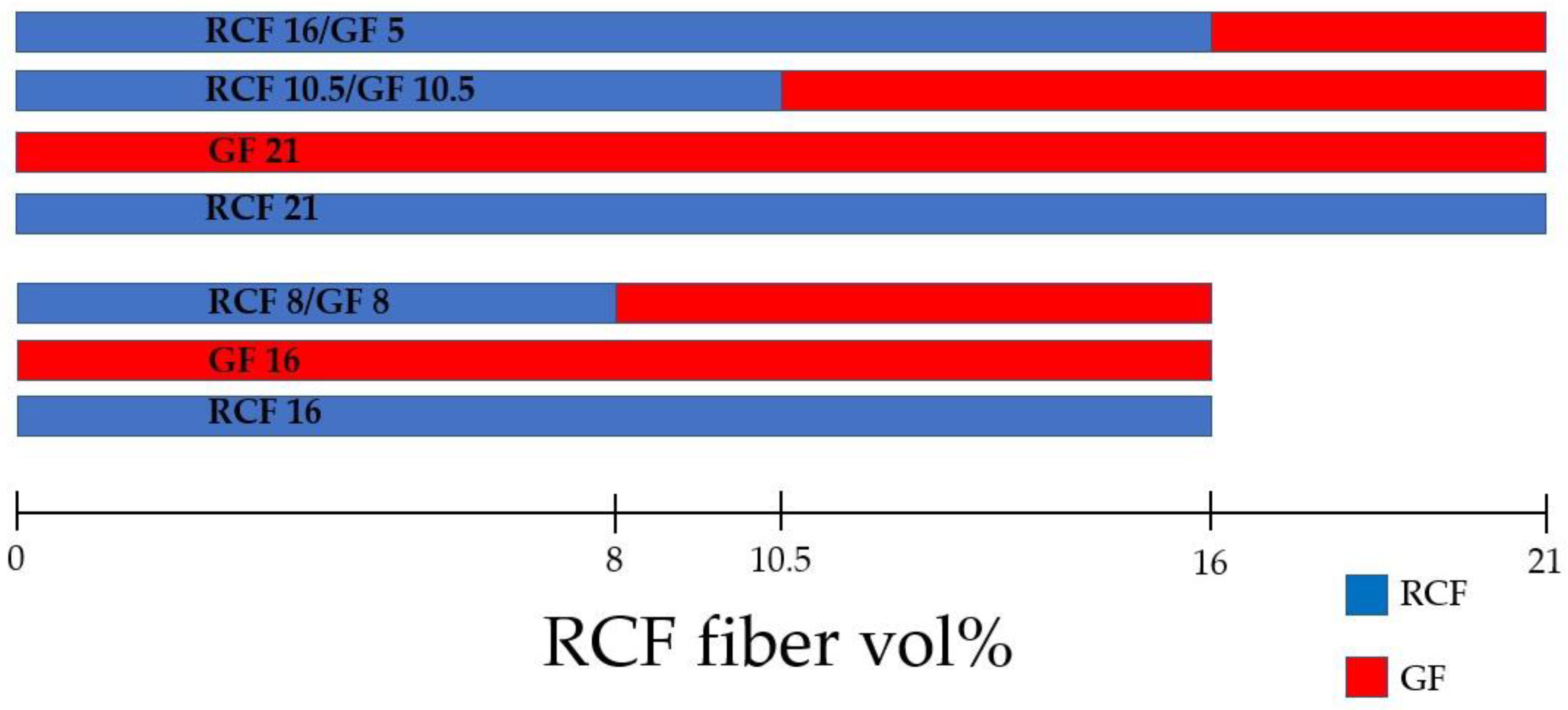
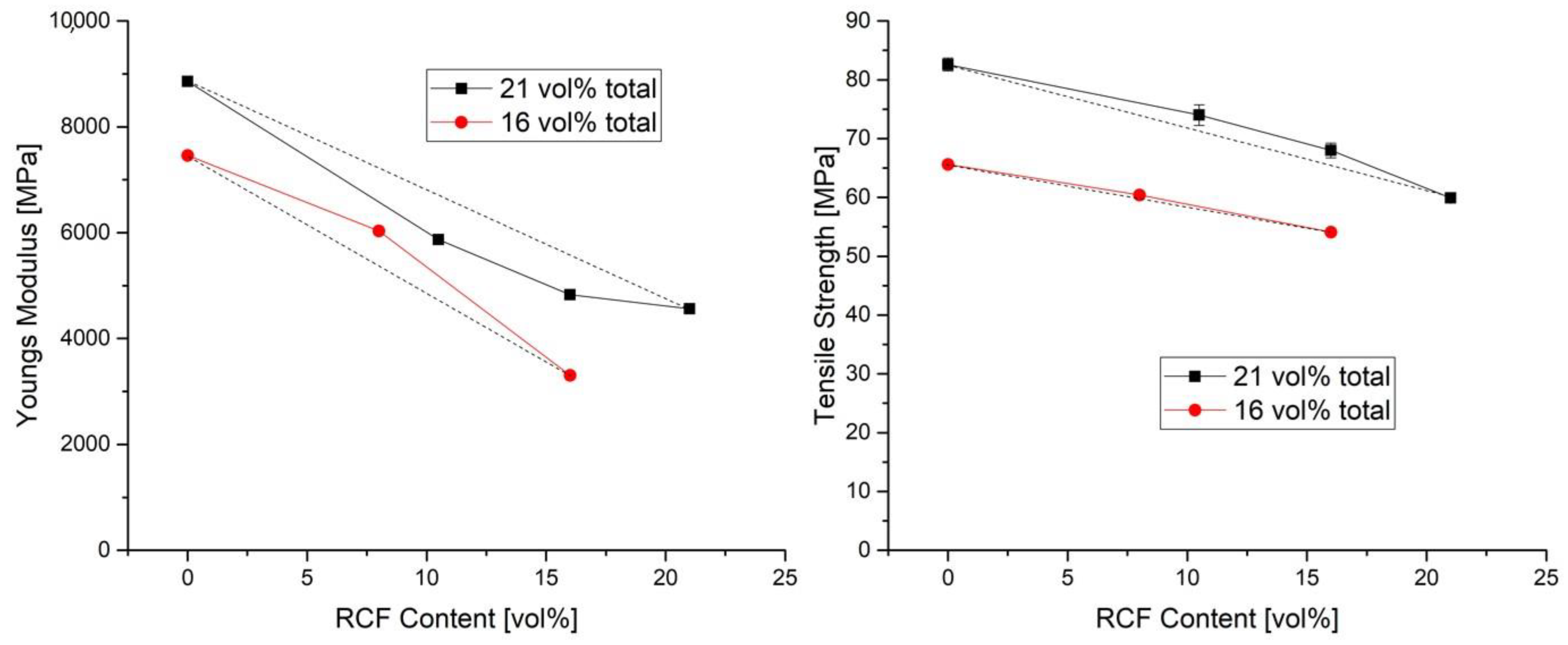


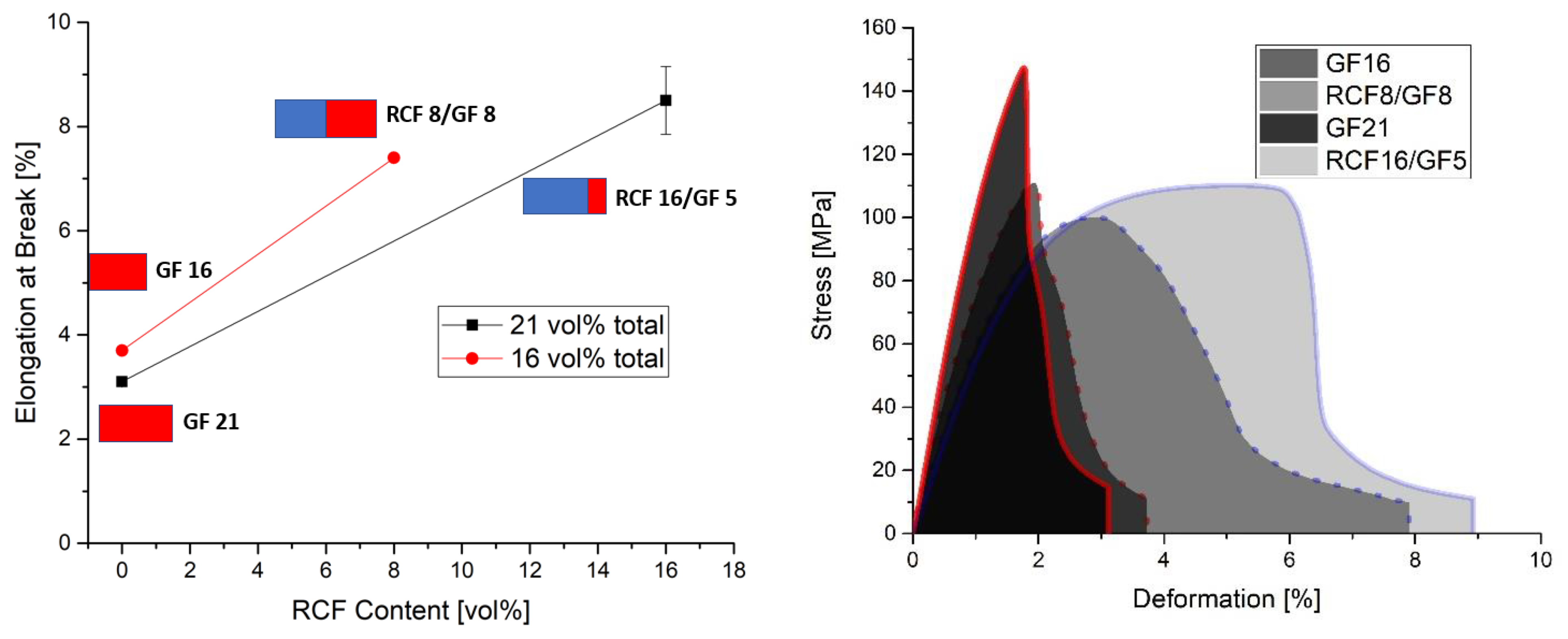
| Short Fiber Type | E-Modulus [GPa] | Strength [MPa] | Elongation at Break [%] | Fiber Diameter [µm] |
|---|---|---|---|---|
| RCF Cordenka CR Type | 22 | 825 | 13 | 12 |
| GF Lanxess CS 7952 | 73 | 2600 | 3.5 | 14 |
| Zone | 1 | 2 | 3 | 4 | 5 | 6 | 7 | Nozzle |
|---|---|---|---|---|---|---|---|---|
| Temperature [°C] | 170 | 190 | 190 | 180 | 180 | 180 | 180 | 185 |
| Impact Test Charpy | Tensile Test | |
|---|---|---|
| GF21 | 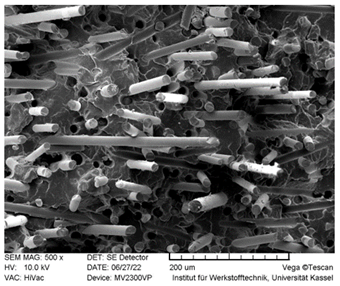 | 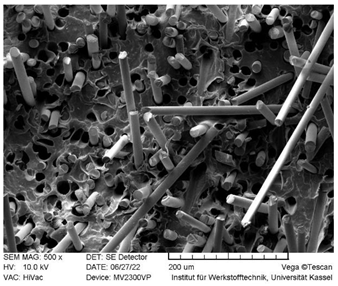 |
| RCF16/GF5 | 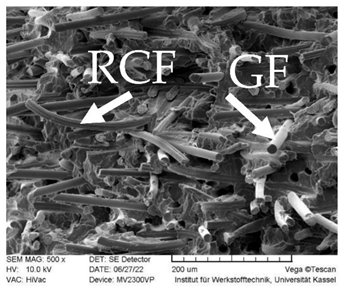 |  |
| RCF 16 |  |  |
Publisher’s Note: MDPI stays neutral with regard to jurisdictional claims in published maps and institutional affiliations. |
© 2022 by the authors. Licensee MDPI, Basel, Switzerland. This article is an open access article distributed under the terms and conditions of the Creative Commons Attribution (CC BY) license (https://creativecommons.org/licenses/by/4.0/).
Share and Cite
Kahl, C.; Zarges, J.-C.; Heim, H.-P. Influence of Fiber Volume in Hybrid Short Glass/Cellulose Reinforced Thermoplastic Compounds. Polymers 2022, 14, 3929. https://doi.org/10.3390/polym14193929
Kahl C, Zarges J-C, Heim H-P. Influence of Fiber Volume in Hybrid Short Glass/Cellulose Reinforced Thermoplastic Compounds. Polymers. 2022; 14(19):3929. https://doi.org/10.3390/polym14193929
Chicago/Turabian StyleKahl, Christian, Jan-Christoph Zarges, and Hans-Peter Heim. 2022. "Influence of Fiber Volume in Hybrid Short Glass/Cellulose Reinforced Thermoplastic Compounds" Polymers 14, no. 19: 3929. https://doi.org/10.3390/polym14193929
APA StyleKahl, C., Zarges, J.-C., & Heim, H.-P. (2022). Influence of Fiber Volume in Hybrid Short Glass/Cellulose Reinforced Thermoplastic Compounds. Polymers, 14(19), 3929. https://doi.org/10.3390/polym14193929






